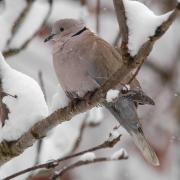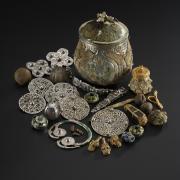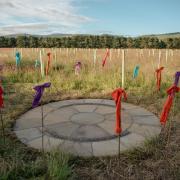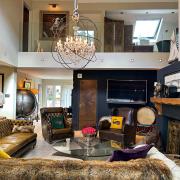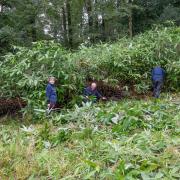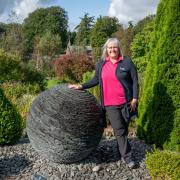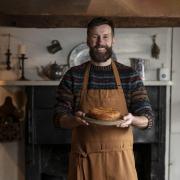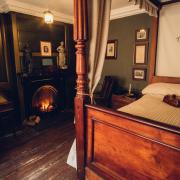Sun-kissed beaches, memories of childhood summers, sea, shells and pebbles, even lichen are the inspiration behind nature-loving Langholm jeweller Lisa Rothwell-Young’s beautiful collections. And as she tells Carol Hogarth, she also loves the stories of her customers which she uses to create stunning bespoke pieces of jewellery, specially made to last a lifetime
Wild places - from the Northumberland coast to the Greek islands, and hills and woodland closer to home - are the inspiration for Lisa Rothwell-Young’s ethical fine jewellery.
Based in her own workshop and gallery in Henry Street, Langholm, Lisa helps customers mark significant memories and milestones with luxury, handmade jewellery using ethically sourced precious metals and gemstones.

She works closely with her customers to produce unique, bespoke pieces; she can re-model customers’ own jewellery giving old materials a new lease of life, and she has four collections inspired by her love of nature and natural landscapes.
“I’ve always been outdoorsy. I grew up in Lancashire, pony daft, and spent my weekends on a horse up a hill or with my dad on his allotment,” she says.
When her parents moved to the Langholm area in 2000, she followed them, excited by the area’s remote and unspoilt landscapes. She met her now husband Barry, whose family are from Lockerbie, and the couple settled in their home between Langholm and Eskdalemuir.

Lisa’s jewellery-making venture began in 2005 when she completed a course at the then Cumbria Institute of the Arts in Carlisle.
“I used to love watching jewellery specialist Geoffrey Munn on the Antiques Roadshow. I’d look at those tiny, intricate, precious things and wonder how you would make them, so I signed up for classes and slowly built up my tools.”
With a degree in history and heritage management, Lisa previously worked for the North of England Civic Trust: “I worked in historical buildings conservation, so I have always had an appreciation of craftsmanship. It’s really important to me that everything is as good as it possibly can be.”

Lisa and Barry, who us a photographer, opened the Cut The Mustard gallery on Langholm’s High Street in 2013 where they sold the work of up to 90 different artists and makers.
“It grew arms and legs. It was just such an enormous undertaking,” she says.
With Barry busy with his photography business and Lisa’s jewellery making developing fast, she realised she couldn’t do everything and “something had to give.”
So Cut The Mustard closed in January 2018 and Lisa focussed on her own work.
“Having the time to concentrate on my jewellery meant it was really able to grow.”

In 2020, Lisa bought and renovated the former grocers’ shop in Henry Street, opening to the public in December 2021.
The welcoming space with its soft green painted walls, natural flooring and period features envelopes customers in Lisa’s vision: “Having my own place where I can work and display my work exactly how I want it, is wonderful. It means the ethos of my jewellery is explained just by walking in here and experiencing it.”
She sees customers mainly by appointment and enjoys spending time with them, getting to know their ideas behind a sought-after piece of jewellery and what’s important to them.

Lisa calls her bespoke jewellery “story pieces” as they incorporate a story from the customer’s life: “Each one starts with a conversation and usually a little thread will emerge and evolve quite naturally. It could be links with family, or a special place or journey. It could be a particular milestone or memory.”
This then goes on to inform Lisa’s creation, with the customer being kept informed every step of the way. Every finished piece, presented in a handmade wooden box by Langholm-based furniture maker Daniel Lacey, is accompanied by a beautifully produced booklet detailing the inspiration, the design process and each step of the making.
“It’s very collaborative,” Lisa says. “These are really special pieces. They’re all handmade, completely unique. It’s about so much more than just a pretty piece of jewellery.
“It’s a lovely thing to do. I get to create these significant pieces of jewellery for people.”

Lisa goes through a similar collaborative process when it comes to remodelling, which she sees as the most sustainable way to create jewellery, reusing what we already have: “Empty your jewellery box of all your broken jewellery, things you don’t like any more, or things you’ve inherited but don’t wear, and which have sentimental value. Bring it all in and we’ll make something beautiful.”
She can use customers’ existing gold or platinum and stones and remodel them into something from her collections - Lichen, Kalimera, Flora and Flow - or use the collections as a basis for the remodelled piece.
Lichen pieces are inspired by the growth patterns of the tough organisms which grow in some of the wildest places on the planet, where their presence is indicative of good air quality and they thrive best in company, making these pieces particularly apt for engagement and wedding jewellery.

Lisa designed the Kalimera collection while sitting on a beach on the Greek island of Kefalonia. These pieces evoke “light glinting off a thousand ripples, sailing boats moored in the harbour and coloured houses tumbling down a cypress strewn hillside”.
Lisa’s Flora jewellery comes from childhood memories of summer afternoons in the garden making daisy chains, bees buzzing, the sound of lawnmowers in the background and the smell of freshly cut grass.
The way the sea ebbs and flows around shells and pebbles on the beach lies behind the Flow collection, which was inspired by Lisa’s love of Lindisfarne, off the coast of north east England.

“This special island is where my sea inspired jewellery collection came to life,” she says.
“All my work is about capturing what these places feel like, that idea of being immersed in the elements, feeling that you don’t need to be anywhere else.”
All the metals Lisa uses in her work have been fairly traded, supporting artisan and small-scale miners with environmental credentials and good working conditions, or have been recycled, involving no new mining.
Her gemstones, including sapphires, rubies and emeralds, and her diamonds come from a handful of traceable sources including a community interest company in Sri Lanka which supports an orphanage and a cooperative in Kenya.
“There’s no perfect way to do it, but once you realise what the cost can be to other people you can’t ignore it. It can be exploitation, children working down mines, illegal mining…”
With the prices of her jewellery ranging from £50 to £30,000, Lisa believes people are realising the value of quality, craftsmanship and sustainability.
“I think we’re being a lot more thoughtful about what we buy. We’re thinking more about where it comes from and what it’s made of.
“There’s fast fashion in jewellery like there is in clothes. I would rather people bought one really nice thing they really wanted which lasted a lifetime.”




